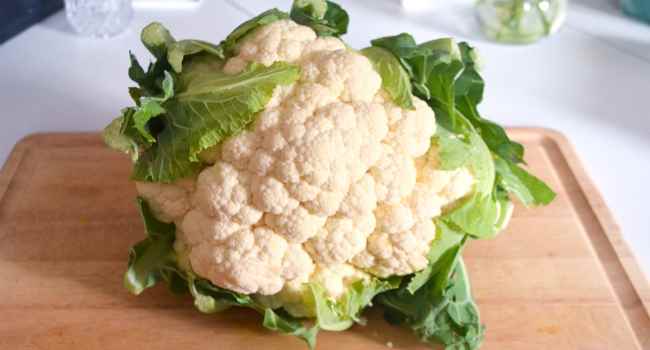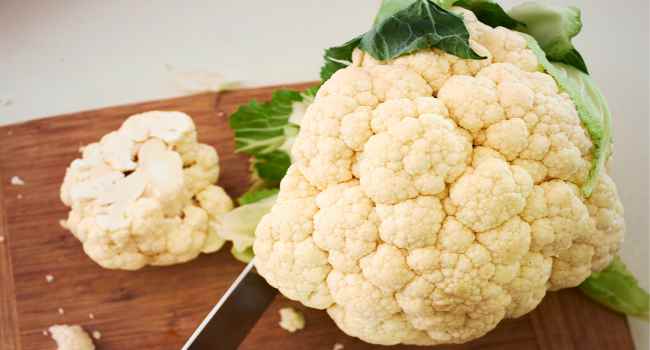Cauliflower — a healthy vegetable that is a valuable source of nutrients. It contains unique plant compounds that can reduce the risk of several diseases such as cancer and cardiovascular diseases. Her the benefits don’t end there. It can prevent diabetes, maintain hormonal balance, relieve indigestion, and lower cholesterol. It is useful for colitis and hypertension, and her antioxidant activity can improve immunity. In addition, she Great suitable for weight loss.
What does cauliflower look like?
Cauliflower (cabbage flower) — one of the familiar vegetables of the winter season. These beautiful flower heads are packed with essential nutrients and contain numerous health benefits phytonutrientsvitamins, indole-3-carbinol and sulforaphane, which help prevent overweight, diabetes and provide protection against prostate, ovarian and cervical cancers.
Almost all consumers cannot resist purchasing this cruciferous herbal product.
But the most useful remains fresh, seasonally grown cauliflower.
This vegetable crop has never been seen in the wild. They say that it was specially bred by the peasants of the Mediterranean about 2.5 thousand years ago.
True, at first, cauliflower was massively grown in the territories of Egypt, Syria and Persia. After all, the Arabs did not appreciate her taste as the medicinal qualities indicated by more famous Avicenna.
About her in 1st century AD spoke Plinycalling her cyno and noting what is the most delicious of all varieties of cabbage.
Further the vegetable came to Spain and Cyprus together with the Arab conquerors. Her the description is found in the writings of the Arab botanists Ibn al-Aullama and Ibn al-Bayter at 12 and 13th century.
From Cyprus, cauliflower seeds migrated to 16th century to France and further to Great Britain and Holland.
In domestic cooking, they learned about cauliflower under Catherine the Great in 18th century… Unfortunately, at that time she was present only at the tables of the aristocracy due to the too high price.
Only the Russian breeder A. Bolotov managed to adapt this thermophilic cruciferous plant to the cold. Though her it is still more common to grow in greenhouses.
Cauliflower belongs to the Cruciferous family of the cultivated species “Cabbage”. It is an annual plant that is grown from seed. Nutritional value is represented only by cabbage inflorescences – white, densely sitting, kochanchiki.
Prefers moist, well-drained, nutritious soils, sun and temperatures within 21—29 degrees. Higher temperatures can cause it to generally not tied, but if tied, then her inflorescences may turn reddish-purple.
Planted her, as a rule, in a seedling way. The very first harvest can be obtained after 7—12 weeks after planting.
Why is cauliflower useful?
Cauliflower is an excellent source of many vitamins and minerals. Among the valuable for nutritionists constituents the chemical composition of this vegetable (cauliflower can be purchased all year round today) are:
Vegetable proteins;
Carbohydrates
Starch;
Fiber (dietary fiber);
Unsaturated fatty acids;
Purine substances;
Antioxidants
A number of vitamins B-groups (niacin, choline, riboflavin, thiamine, pyridoxine, folic and pantothenic acids);
Tocopherol (vitamin E.);
Biotin (vitamin N);
Vitamin D (calciferol);
Ascorbic acid (natural antioxidant vitamin C);
Regulatory clotting blood phylloquinone (vitamin k);
Mineral elements in the form of calcium, magnesium, potassium, sodium, phosphorus, zinc, iron, selenium, manganese, copper, fluorine, cobalt.
Raw cauliflower typically contains up to 30 calories.
In this case, the percentage of energy value for proteins, fats and carbohydrates will be 33/9/56%.
100 grams of cabbage contains 2 grams of fiber. This is not very high, only about 5 percent of the DV.
Dietary fiber is essential for human health. They serve as nourishment for friendly bacteria in the intestines, which help reduce inflammation and improve the functioning of the digestive system.
A diet rich in dietary fiber reduces the likelihood of constipation, the risk of colon cancer, cardiovascular disease, and type 2 diabetes. Fiber also plays a role in the prevention of obesity.
As a source of antioxidants, it is able to protect cells from the oxidative effects of free radicals. Especially there are many glucosinolates and isothiocinates, two phytochemicals that are believed to be scientists, are able to protect the body against the development of colon cancer, breast cancer, prostate cancer, lungs… In addition, they are able to slow down the growth of cancer cells.
One of the most studied antioxidants found in kale is sulforaphane… Studies have shown that it can suppress the development of cancer by way inhibiting enzymes that are involved in the development of cancer and tumors. According to these studies sulforaphane can also inhibit the growth of cancer cells.
In addition, this compound can help lower high blood pressure and protect blood vessels. It also plays a role in the prevention of diabetes, and reduces the risk of complications caused by this disease.
In addition to these antioxidant compounds, it contains others such as carotenoids and flavonoids. What’s more, cauliflower is high in vitamin WITHwhich also acts as an antioxidant.
Due to its low calorie content, it can be a good substitute for high-calorie foods. And thanks to fiber gives a feeling of fullness, which automatically reduces the consumption of excess calories.
We must not forget that it actually contains up to 92 percent of water. It also has an impact on bowel function and weight loss.
Cauliflower contains a number of vitamins of the group B. One Choline plays important roles:
Supports the integrity of cell membranes;
Participates in DNA synthesis;
Regulates metabolism;
Essential for the brain and nervous system;
Prevents the accumulation of cholesterol in the liver;
Reduces the risk of liver and heart disease;
Prevents the development of Alzheimer’s disease and age-related dementia.
High content folate improves the overall metabolism of fats, proteins and carbohydrates.
Cauliflower benefits
Cauliflower is especially valuable not only for those who want to lose weight, but for virtually everyone.
The secret is that cauliflower:
Capable of removing toxic substances;
Reduces the risk of constipation;
Improves the intestinal microflora;
Stabilizes metabolism for check replenishment of the body with enzymes;
May help normalize acidity;
Improves appetite;
Relieves the feeling of heaviness in the stomach;
Heals ulcers duodenal intestines and stomach;
Strengthens the antioxidant protective functions of the body;
Prevents damage and deformation of cells;
Prevents the development of tumors (especially breast and prostate cancer);
In the acute form of gastritis, the vegetable should become mandatory due to its soft structure, which does not irritate the mucous membranes;
Has a mild diuretic effect while helping kidney function;
Promotes better sputum discharge;
Improves liver function and gall bubble behind check working out bile secretion;
Lowers high blood pressure;
Removes “bad” cholesterol from the vascular system;
Vegetable gruel promotes better tissue regeneration when applied externally to a burn or wound.
In cosmetology, cauliflower serves as a base for creating face masks.
How to choose a cauliflower
So that the plant product does not spoil the positive impression of its consumption, you should not forget about the rules for choosing heads of cauliflower.
They boil down to the following norms:
- Increased strength of the head of cabbage;
- Ripe product – heavy;
- They talk about freshness green leaflets;
- Depending on the varietal variety and growing conditions, cabbage can have white, grayish, yellow, purple or green color;
- Dark there should be no stains on the cabbage.
It is allowed to store the product only in a refrigerator at a temperature of 0 degrees for no more than 12 days.
What is made from cauliflower
In cooking, cauliflower is prized for its wide variety of dishes that include a vegetable.
Most often her boil in a saucepan for about 15 minutes with a whole head of cabbage or disassembled into inflorescences. In a steamer or multicooker, the time for readiness reaches up to 30—40 minutes (it is recommended to pour boiling water into the multicooker bowl).
For the best taste, it is recommended to pour the cabbage with low-fat milk and cream when boiling.
Boiled cabbage until half cooked can be fried in egg batter (eggs are beaten with black pepper, nutmeg, salt) or in a batter of only egg whites. Truth, dietetic such a product is highly questioned.
When stewing (preferably in a stewpan with high sides and the addition of exclusively vegetable unrefined sunflower or olive oil), various vegetables, ground spices to taste and beef sliced or finely chopped chicken are additionally added. Then you can put this mixture in the oven and sprinkle solid cheese. Again, talk about low calorie inappropriate here.
As a medical food, boiled cauliflower is prepared in the form of mashed potatoes (whipped with a blender).
For the winter, cabbage inflorescences are frozen, pickled and canned. The processes are no different from the standard ones: the inflorescences are washed, dried on a paper towel, placed in pasteurized jars, filled with brine with a mixture of salt and sugar (the first three fillings are merged) and rolled under the lids.
Contraindications and harm
Although boiled or baked, and the most delicious fried, cauliflower is seemingly harmless and supposedly can not bring harm, nevertheless, harm is relatively her consumption may manifest.
This vegetable is not recommended in any form at:
- Availability hypothyroidism and the rest violations in the functioning of the thyroid gland;
- Increased acidity of the stomach (regulation of gastric juice occurs with decreased secretion, and with an ulcer, the bad condition can be aggravated);
- Problems with the intestines or all in all with the stomach;
- Gout and her manifestations (due to purine compounds);
- «Рstretching»Stomach (this usually occurs when abuse products from this vegetable);
- Dietary fractional nutrition (a person may not keep track of the required grams and quickly get full without thinking about the need for control);
- Violations intestinal microflora (there may be disorders and indigestion).
Indigestion and flatulence may occur if eaten raw. This combination is not recommended. given type of cabbage: with apples, plums, legumes and bran bread.
Why is cauliflower useful?
How to make cauliflower cutlets in this video
